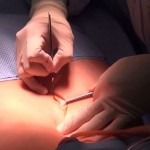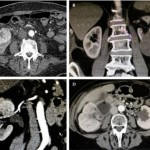Editorial: Complex tumours, partial nephrectomy and functional outcomes
In the paper by Volpe et al. [1], excellent renal functional outcomes are associated with partial nephrectomy in patients with high PADUA score cancers. The study is notable because it shows that, even in patients who are typically considered candidates for radical nephrectomy, partial nephrectomy can maintain excellent estimated GFR (eGFR) and outcomes; however, because we perform nephron-sparing procedures on patients who may also be candidates for radical nephrectomy, we must consider the varied nature of some of the data on partial nephrectomy.
The literature on renal ischaemia and functional outcomes is heterogeneous and highly debated [2]. There have been several contradictory studies and changes over time in the literature based on technology, surgeon, centre, measurement and, now, correlation with parenchyma-sparing.
A study conducted by the European Organisation for the Research and Treatment of Cancer (EORTC) compared radical nephrectomy (essentially an ischaemic time of infinity) and partial nephrectomy, reporting a 10-year overall survival benefit for patients treated with radical nephrectomy [3]. Nevertheless, this oft-criticized randomised trial also showed better eGFR in partial nephrectomy. The survival benefit reported in that study is countered by population-based studies suggesting that partial nephrectomy may still be a better option when feasible [4]. Unfortunately, these population-based studies may be considered to provide a lower level of evidence than a randomised study, and are also prone to several biases, the most notable being selection of both patients and centres. Surgeons may be more likely to perform nephron-sparing in patients in lower-risk groups. There are also other questions to consider. If a patient is more likely to be referred to a larger centre for partial nephrectomy, are they not also likely to be referred for their coronary artery bypass, aortic surgery, general medical care and even emergency care? Are these patients more likely to seek out second opinions for all of their medical care? Will this affect mortality? Are they more motivated and engaged in their own overall healthcare? These are just a few of the confounding factors that could influence outcomes and are difficult to control in population-based studies. Nevertheless, I am a firm believer in partial nephrectomy, and particularly in preserving renal function, as the better choice for the treatment of both straightforward and complex lesions. It will be difficult, however, to completely negate the implications of the EORTC trial.
Does reasonable ischaemic time affect eGFR outcome? The present study by Volpe et al. [1] would suggest that reasonable ischaemic times are completely acceptable. Several contradictory studies point out the benefits and risks of a limited or minimized clamp time for partial nephrectomy. Another separate paper by White et al. [5] is consistent with other studies that show that a clamped partial nephrectomy, even for high complexity masses, results in a minimal loss of renal function, if at all. Although there is also enthusiasm for a zero ischaemia technique, it is critical to point out that this may be surgeon-, patient-, technique- and institution-dependent. Ultimately, however, we are splitting hairs over a few points of eGFR. The real issue with long-term GFR outcomes in our patients is not only the impact of a few minutes of renal ischaemia, but also control of hypertension, diabetes and their role in medical renal disease. There is an absence of urological literature that controls for patients’ glycated haemoglobin levels or measures hypertension monthly and records the response to medical therapy. These critical pieces of information confound all eGFR and comparative measurements and make it difficult to compare published outcomes. Perhaps the best medical advice we can give patients is to diet, exercise and eat healthily for better overall health. In some sense, this advice may be far more important than the decision of partial vs radical nephrectomy for a complex mass.
What are the logical conclusions of these dilemmas? Clamped partial nephrectomy is possible in complex cases, and the procedure salvages eGFR. Further refinements are also interesting academically, including papers on parenchyma-sparing. Nevertheless, if we are serious about ‘healthy kidneys’, we might take a holistic approach and encourage our patients to pursue a healthier lifestyle so they can bolster lifelong preservation of renal function and general wellness. Would the effect be more profound than a few minutes of ischaemic time? I am betting it would.
Sam B. Bhayani
Division of Urological Surgery, Washington University School of Medicine and Barnes-Jewish West County Hospital, St Louis, MO, USA
References
1 Volpe A, Garrou D, Amparore D et al. Perioperative and renal functional outcomes of elective robot-assisted partial nephrectomy for renal tumors with high surgical complexity. BJU Int 2014; 114: 903–9
2 Lane BR, Russo P, Uzzo RG et al. Comparison of cold and warm ischemia during partial nephrectomy in 660 solitary kidneys reveals predominant roles of nonmodifiable factors in determining ultimate renal function. J Urol 2011; 185: 421–7
3 Van Poppel H, Da Pozzo L, Albrecht W et al. A prospective, randomized EORTC intergroup phase 3 study comparing the oncologic outcome of elective nephron-sparing surgery and radical nephrectomy for low-stage renal cell carcinoma. Eur Urol 2011; 59: 543–52
4 Sun M, Trinh Q-D, Bianchi M et al. A non-cancer related survival benefit is associated with partial nephrectomy. Eur Urol 2012; 61: 725–31
5 White MA, Georges-Pascal H, Autorino R et al. Outcomes of robotic partial nephrectomy for renal masses with nephrometry score of ≥ 7. Urology 2011; 77: 809–13



